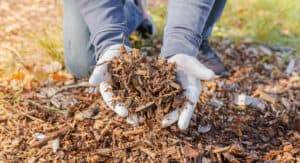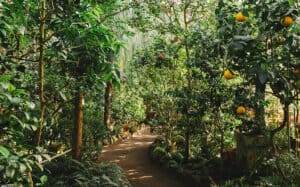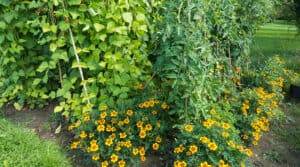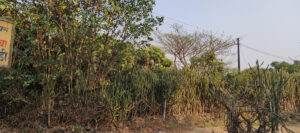Trees are, of course, an important part of many permaculture designs. But as we seek to create systems that generate yields of us as well as working holistically for the broader good of people and planet, we also have to ask ourselves how we should best manage our trees and tree-based systems.
Pollarding and coppicing are both interesting age-old techniques that can be used in holistic and sustainable permaculture systems to meet our goals and deliver a range of yields.
But what precisely do we mean by these terms? When are these strategies useful and why? When should we use these strategies and what precisely do they involve?
Read on to learn more about these advanced permaculture pruning techniques.
To Prune or Not to Prune?
One key question that often crops up is when and if to prune various different trees. Some people are of the opinion that we should prune regularly and keep things very tightly in check to keep the plants and system healthy, while others believe that we should let nature run its course and intervene as little as possible.
On the whole, my view is somewhere in the middle. Some judicious pruning of forest garden/ orchard trees can keep trees in good health but a minimal approach is generally best, pruning for purely aesthetic reasons is unnecessary and often, nature can do just fine on its own without our intervention.
Looking beyond the basic question of to what degree we should prune for the health and well-being of the tree and of the system as a whole, we can also often, in permaculture, look beyond this to discover advanced pruning techniques that might be of benefit in our designs.
Pollarding and coppicing are two terms that often crop up when we are talking about sustainable tree-based systems to meet human needs.
Pollarding and coppicing might seem a bit complicated at first. But there are many reasons why these tree management techniques can be very important in permaculture design, and can play an crucial role in many permaculture systems.
What Are Pollarding and Coppicing?
Pollarding and coppicing are both methods of pruning (or harvesting) that allow us to obtain yields of wood from certain trees while still keeping living roots in the soil.
Pollarding is a term that refers to the removal of all the upper branches of a tree through pruning. This practice promotes the growth of a dense head of branches and leaves. On a rotating cycle, typically between 2 and 15 years, the material from the top of the tree is harvested for use in a range of ways.
In a coppicing system, trees are cut down even more drastically, close to the base, which encourages multiple new trunks or branches to form. These are then also harvested on a rotational system, so that the ecosystem is maintained.
Both of these practices have a long history of use in Europe, though are, perhaps, less well-known in other regions.
Why Pollarding and Coppicing are Useful in Permaculture Systems
You will often find pollarding or coppicing systems in permaculture designs. Pollarding is more common in systems where livestock are incorporated, since this technique allows the productive part of trees to stand above the height reached by livestock below. It is also often employed on street trees in Europe.
Coppicing is undertaken in a wider range of situations but most typically in native woodland or forest management, and in agroforestry and forest gardening.
These strategies can allow us to:
- Maintain living stands of trees, woodland or forest on managed land.
- Enrich the biodiversity of an ecosystem.
- Obtain a wide range of useful yields for ourselves and our livestock.
Maintain Living Trees Long-Term on Managed Land
One of the key concerns of sustainable management of tree-based ecosystems is making sure that living trees can be maintained not only for a time until they are clear-felled but long term.
Of course, humans have a long history of utilizing trees for construction and crafting materials, fuel, and other yields. Unfortunately, our desire for wood for various uses is often a leading cause of deforestation. Forests and plantations of trees are often clear-felled to meet our needs.
But when we chop down trees and clear-fell an area to meet our needs, we lose all the ecological benefits and ecosystem services that those trees provide.
One major problem with many forestry approaches are that there is a false equivalence between established tree-based ecosystems and newly planted forestry plantations.
An area of forest or a plantation chopped down is often replaced in so-called sustainable forestry with new trees. But new plantings cannot hope to replace what was taken – not in the short term at least and often not for a very long time, if at all.
Living trees, whether in a natural forest ecosystem or in a managed plantation, felled when mature would have, while standing, sequestered carbon, improved the environment, protected the soil and provided all the other myriad benefits that trees provide. Newly planted trees cannot provide for the ecosystem, or for us, in the same ways.
Pollarding and coppicing offer the opportunity to manage tree-based systems more sustainably. We can still obtain what we need while also keeping a living tree standing to provide the many ecosystem services trees can provide, protecting the soil etc…
One crucial thing we all need to remember is that trees are much more valuable – in every sense – when left standing than they are once felled.
In the UK, including where I live here in Scotland, and in many other parts of the world, pollarding and coppicing have allowed productive tree-based systems to be managed for hundreds and perhaps even thousands of years.
Managed forests and woodlands, of course, cannot hope to deliver the same ecological benefits as a true old-growth forest or ancient wild wood.
But they can become sustainable, ecologically sound systems that balance ecological needs with human needs long-term and fulfil permaculture ethical desires and goals.
Trees that are pollarded or coppiced do not age and die as normal. Instead, the extreme pruning resets the aging process – maintaining the upper portions of the tree at a juvenile stage in its lifecycle. The age of a trunk or stool can be staggering, far outstripping the age to which a tree would typically grow if entirely unmanaged.
Enrich the Biodiversity of an Ecosystem
Intervening in minimal ways is often crucial in protecting ancient woodlands and old-growth forests. But when it comes to maintaining trees in afforested areas, productive forestry schemes, in agroforestry schemes, on homesteads or smallholdings or in gardens, some hands-on management can be beneficial to the system as a whole.
Often in conservation circles, people speak of ‘wildernesses’ but forget or fail to acknowledge that many areas considered to be pristine and \untouched’ were actually long shaped by human hands. In many cases, humans were key factors within an ecosystem.
People have not just destroyed – around the world, indigenous groups and native communities have shaped the natural environment around them in ways that have actually lead to enrichment and allowed a greater diversity of life to flourish.
Learning from other large mammals and ecosystem engineers, we can see how to prune, manage, tend, and alter our environments – working in harmony with the natural world and harnessing natural processes not only to get what we need, but also to leave things better than we found them.
Pollarding and coppicing of native trees in certain bioregions, for example, has long been known to allow light to the forest floor, leading to a proliferation of plant and animal life. Managed woodlands can actually sometimes be more biodiverse than equivalent natural woodlands.
When these strategies are undertaken correctly and carefully alongside other sustainable permaculture forestry techniques, they can be wonderful for wildlife and improve the stability and resilience of the system.
Obtain Multiple Yields
Pollarding and coppicing allow us to obtain a number of yields of construction wood, crafting wood, fodder, firewood/ fuel and woody biomass to maintain or enhance fertility in the soil from living trees, not only once but repeatedly, on a cycle, to obtain multiple harvests over many years.
These pruning strategies have been used to harvest wood that can potentially be used for a range of things including:
- Building materials (for use in our homes, gardens etc..)
- Crafting materials (to make tool handles, canes, baskets and other woven goods, etc..)
- Fodder & ‘tree hay’ (to feed livestock)
- Firewood and fuel (for space heating, hot water heating, cooking etc…)
- Mulch/ composting materials (to maintain growing systems and protect and enhance the soil).
For example, on my own property, we coppice different trees for crafting.
We coppice some also to provide kindling for our Rayburn stove, which provides us with our space and water heating and which is used for cooking over the winter months.
(We cannot grow all the fuel we need on our 1/3 acre property, but supplement the wood we purchase from our neighbor who has increased woodland cover and manages it sustainably on their estate, with coppiced wood from the garden.)
I also use coppiced wood, shredded using a garden shredder or chipper, to create a mulch that I use for pathways and in my forest garden.
Which Trees can Be Used in Pollarding or Coppicing Systems?
Of course, not all trees can be used in pollarding or coppicing systems. When drastically lopped back on the crown or pruned to the base, not all trees can recover.
Some Trees Suited To Pollarding or Coppicing
Of course, you will need to consider where you live, and trees native to your area, or which thrive in the environment that can be provided on your property. But here are some tree species that can often be useful for pollarding or coppicing schemes within permaculture designs:
- Alder – as a nitrogen fixer, alder is beneficial as a pioneer tree. Coppiced, it can remain relatively small and the wood is great for soil building and fertility. Where I live, common alder can also be a great native tree for hedgerows in damp areas.
- Ash – an excellent firewood, we have coppiced ash that grow like weeds around our property to provide us with a source of kindling or firewood (once seasoned). This is a great fuel wood. Ash is also useful for crafting, making tool handles, furniture, posts etc…
- Birch – birch is another tree that we coppice for kindling wood or faggots of fuel wood. It can be useful when coppiced on quick rotation.
- Black Locust – this is another tree used in coppice systems. It is a good firewood, fodder or biomass crop and is a North American native.
- Dogwoods – Ornamental stems of some dogwoods, when coppiced on a relatively quick rotation, can be used in basketry and a range of other crafts. Cornus sanguinea, for example, has flexible young stems that are beautiful and useful, and the wood is used for making small items like handles, to make charcoal, or to provide an excellent fuel.
- Elder – this fast-growing productive tree is a good source of biomass. I tend to use elder coppiced in my garden in a mulch for my forest garden and pathways.
- Elm ssp. – elms have potential in the arena of agroforestry, and are also sources of durable wood that can be used for a range of crafts.
- Hazel – another typical coppice tree, hazel does not just provide edible nuts. We coppice it here to provide materials for the garden – for wattle fencing, stakes and support structures, for example.
- Lime – coppiced strongly, or pollarded, lime produces good straight stems that are very useful for a range of crafts in addition to producing edible leaves.
- Mulberry ssp. – mulberry is a good choice for pollarding or coppicing for animal fodder, and also provides wood for fencing etc. as well as edible berries and leaves.
- Oak – oak is suitable for a much longer-term coppicing rotation – typically around 50 years. It produces a top-notch wood wonderful for construction timbers, craft, or fuel. Some find that pollarding provides better results than coppicing when it comes to regrowth on some oak species.
- Willow – willow is coppiced on quick rotation and is often a favourite for basketry and other crafts. Young willow growth, known as ‘whips’ have a huge number of uses around homes and in gardens.
This is by no means an exhaustive list. There are other trees that might be suitable. But remember, not all trees will be suitable for pollarding or coppicing. Not all will grow back when you prune them back severely.
The species suited to these methods are those with strong epicormic growth. (Epicormic buds are dormant buds that lie dormant below the bark of a tree, which grow active shoots when upper portions of the plant are damaged.) many broadleaf species have this feature, but conifers, for example, tend not to.
If we select the right species, pollard or coppice them on the right rotation for our needs, and think carefully about what we wish to achieve, we can harness these techniques to work with nature and achieve our sustainability goals.







